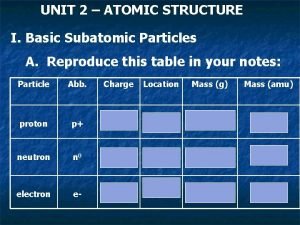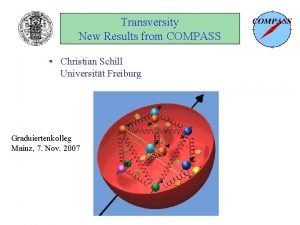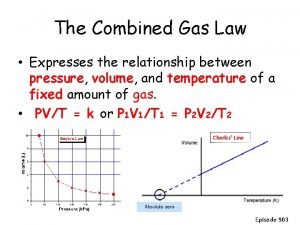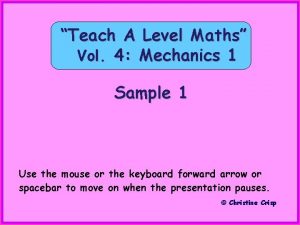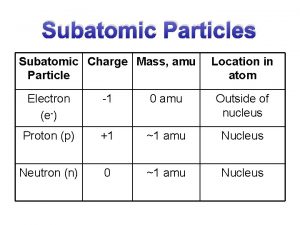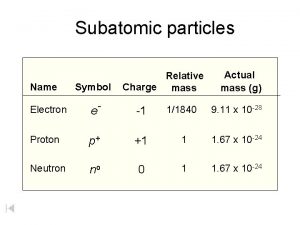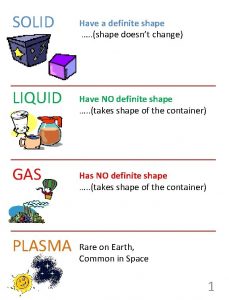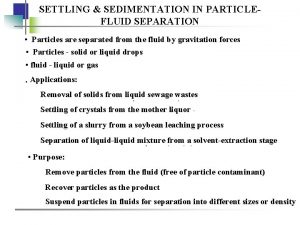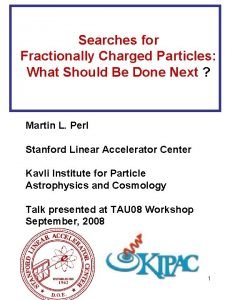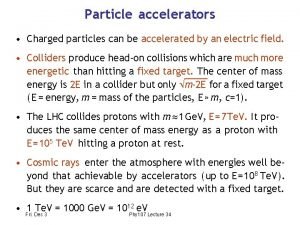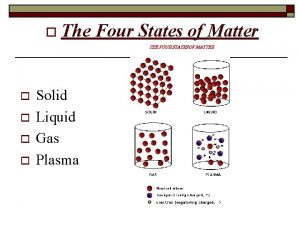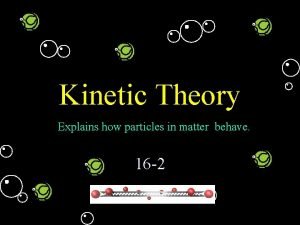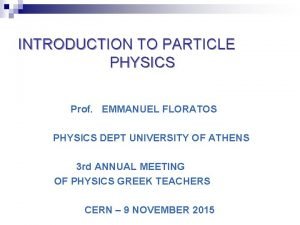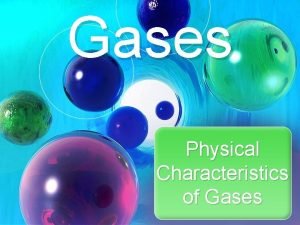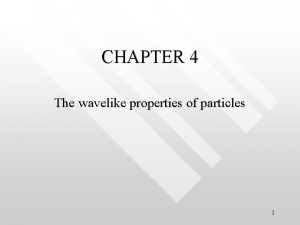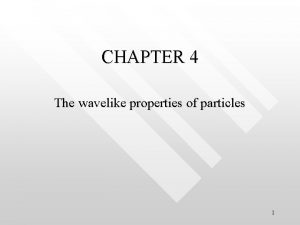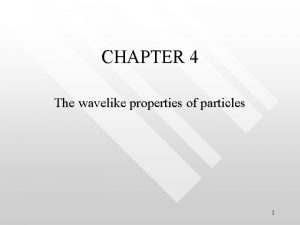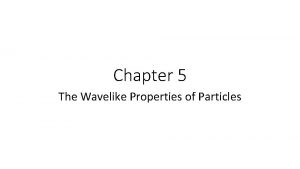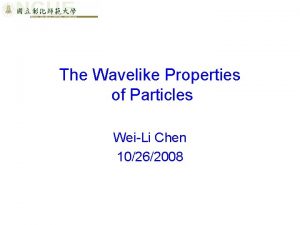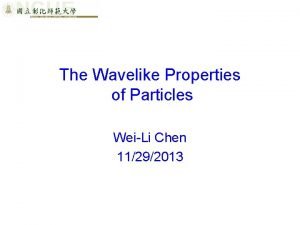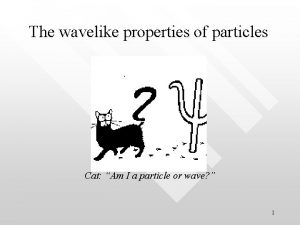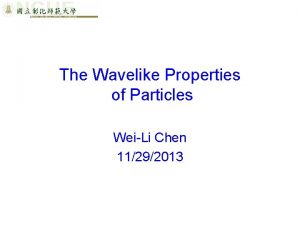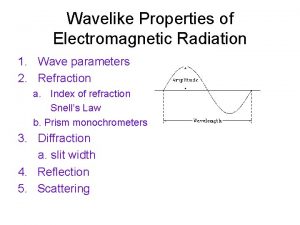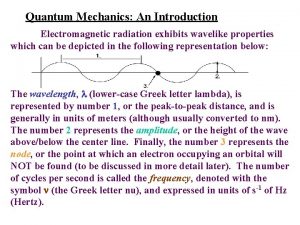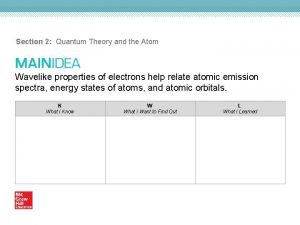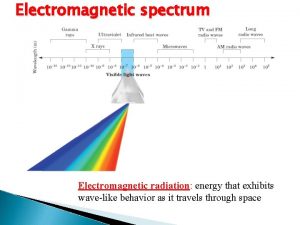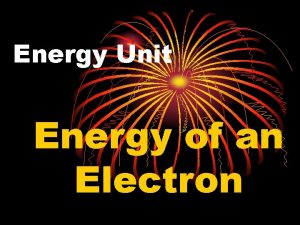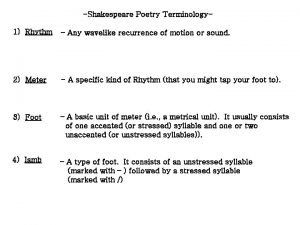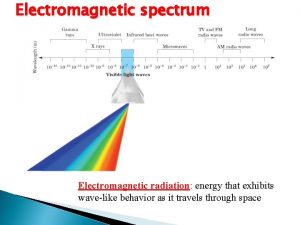CHAPTER 4 The wavelike properties of particles 1






































































- Slides: 70

CHAPTER 4 The wavelike properties of particles 1

Schroedinger’s Cat: “Am I a particle or wave? ” 2

Wave particle duality • • • “Quantum nature of light” refers to the particle attribute of light “Quantum nature of particle” refers to the wave attribute of a particle Light (classically EM waves) is said to display “wave-particle duality” – it behave like wave in one experiment but as particle in others (c. f. a person with schizophrenia) 3

• • • Not only light does have “schizophrenia”, so are other microscopic “particle’’ such as electron, i. e. particles also manifest wave characteristics in some experiments Wave-particle duality is essentially the manifestation of the quantum nature of things This is an very weird picture quite contradicts to our conventional assumption with is deeply rooted on classical physics or intuitive notion on things 4

Planck constant as a measure of quantum effect • • • When investigating physical systems involving its quantum nature, theory usually involves the appearance of the constant h e. g. in Compton scattering, the Compton shift is proportional to h; So is photoelectricity involves h in its formula In general, when h appears, it means quantum effects arise In contrary, in classical mechanics or classical EM theory, h never appear as both theories do not take into account of quantum effects Roughly quantum effects arise in microscopic system (e. g. on the scale approximately of the order 10 -10 m or smaller) 5

Wavelike properties of particle • • In 1923, while still a graduate student at the University of Paris, Louis de Broglie published a brief note in the journal Comptes rendus containing an idea that was to revolutionize our understanding of the physical world at the most fundamental level: That particle has intrinsic wave properties For more interesting details: http: //www. davisinc. com/physics/index. shtml Prince de Broglie, 1892 -1987 6

de Broglie’s postulate (1924) • The postulate: there should be a symmetry between matter and wave. The wave aspect of matter is related to its particle aspect in exactly the same quantitative manner that is in the case for radiation. The total (i. e. relativistic) energy E and momentum p of an entity, for both matter and wave alike, is related to the frequency f of the wave associated with its motion via Planck constant p = h/l, E = hf 7

A particle has wavelength!!! l = h/p • • • is the de Broglie relation predicting the wave length of the matter wave l associated with the motion of a material particle with momentum p Note that classically the property of wavelength is only reserved for wave and particle was never associate with any wavelength But, following de Broglie’s postulate, such distinction is removed A particle with momentum p is pictured as a wave (wavepulse) Particle with linear momentum p Matter wave with de Broglie wavelength l = p/h 8

A physical entity possess both aspects of particle and wave in a complimentary manner BUT why is the wave nature of material particle not observed? Because … 9

• Because…we are too large and quantum effects are too small • Consider two extreme cases: (i) an electron with kinetic energy K = 54 e. V, de Broglie wavelength, l = h/p = h / (2 me. K)1/2 = 1. 65 Angstrom. Such a wavelength is comparable to the size of atomic lattice, and is experimentally detectable • • (ii) As a comparison, consider an macroscopic object, a billard ball of mass m = 100 g moving with momentum p p = mv 0. 1 kg 10 m/s = 1 Ns (relativistic correction is negligible) It has de Broglie wavelength l = h/p 10 -34 m, too tiny to be observed in any experiments The total energy of the billard ball is • E = K + m 0 c 2 ≈ m 0 c 2 = 0. 1 (3 108)2 J = 9 1015 J (K is ignored since K<< m 0 c 2) The frequency of the de Broglie wave associated with the billard ball is f = E/h = m 0 c 2/h= (9 1015/6. 63 1034) Hz =1078 Hz, impossibly high for any experiment to detect 10

Matter wave is a quantum phenomena • • This also means that the wave properties of matter is difficult to observe for macroscopic system (unless with the aid of some specially designed apparatus) The smallness of h in the relation l = h/p makes wave characteristic of particles hard to be observed The statement that when h 0, l becomes vanishingly small means that: the wave nature will become effectively “shut-off” and appear to loss its wave nature whenever the relevant p of the particle is too large in comparison with the quantum scale characterised by h 11

How small is small? • • • More quantitatively, we could not detect the quantum effect if h/p ~ 10 -34 Js/p (dimension: length, L) becomes too tiny in comparison to the length scale discernable by an experimental setup (e. g. slit spacing in a diffraction experiment) For a numerical example: For a slit spacing of l~ nm (interatomic layer in a crystal), and a momentum of p=10 Ns (100 g billard ball moving with 10 m/s), h/p =10 -34 Js/p = 10 -34 Js/10 Ns ~ 10 -35 m << l ~ nm LHS, i. e. h/p (~10 -35 m) , is the length scale of the de Broglie (quantum) wavelength; RHS, i. e. l (~ nm), is the length scale charactering the experiment Such an experimental set up could not detect the wave length of the moving billard ball. 12

The particle’s velocity v 0 is identified with the de Broglie’ group wave, vg but not its phase wave vp vp, could be larger than c 13

Example • • • An electron has a de Broglie wavelength of 2. 00 pm. Find its kinetic energy and the group velocity of its de Broglie waves. Hint: The group velocity of the d. B wave of electron vg is equal to the velocity of the electron, v. Must treat the problem relativistically. If the electron’s de Broglie wavelength l is known, so is the momentum, p. Once p is known, so is the total energy, E and velocity v. Once E is known, so will the kinetic energy, K. 14

Solution Total energy E 2 = c 2 p 2 + m 02 c 4 • K = E - m 0 c 2 = (c 2 p 2 + m 02 c 4) ½- m 0 c 2 = ((hc/l)2 + m 02 c 4) ½- m 0 c 2= 297 ke. V • vg= v; 1/g 2 = 1 – (v/c)2; • (pc)2 = (gm 0 vc)2= (hc/l)2 (from Relativity and de Broglie’s postulate) (gv/c)2= (hc/l)2/(m 0 c 2)2=(620 ke. V/510 ke. V)2 = 1. 4884; (gv/c)2 = (v/c)2 / 1 - (v/c)2 vg /c=√(1. 4884/(1+1. 4884))=0. 77 • 15

Alternatively The previous calculation can also proceed via: • K=(g -1)mec 2 • g = K/(mec 2) + 1 =297 ke. V/(510 ke. V) + 1 =1. 582; • p = h/l = gmev v = hc/(lgmec) • v/c = hc/(l g mec 2) • = (1240 nm∙e. V) /(2 pm∙ 1. 582∙ 0. 51 Me. V) • = 0. 77 • 16

Interference experiment with a single electron, firing one in a time • • • Consider an double slit experiment using an extremely small electron source that emits only one electron a time through the double slit and then detected on a fluorescent plate When hole 1 (hole 2) is blocked, distribution P 1 (P 2) is observed. P 1 are P 2 are the distribution pattern as expected from the behaviour of particles. Hence, electron behaves like particle when one of the holes is blocked What about if both holes are not blocked? Shall we see the distribution simply be P 1 + P 2? (This would be our expectation for particle: Their distribution simply adds) 17

Electrons display interference pattern • • • When one follows the time evolution of the pattern created by these individual electron with both holes opened, what sort of pattern do you think you will observed? It’s the interference pattern that are in fact observed in experiments At the source the electron is being emitted as particle and is experimentally detected as a electron which is absorbed by an individual atom in the fluorescent plate In between, we must interpret the electron in the form of a wave. The double slits change the propagation of the electron wave so that it is ‘processed’ to forms diffraction pattern on the screen. Such process would be impossible if electrons are particle (because no one particle can go through both slits at the same time. Such a simultaneous penetration is only possible for wave. ) Be reminded that the wave nature in the intermediate states is not measured. Only the particle nature are detected in this procedure. OR ? 18

• • • The correct explanation of the origin and appearance of the interference pattern comes from the wave picture Hence to completely explain the experiment, the two pictures must somehow be taken together – this is an example for which both pictures are complimentary to each other Try to compare the last few slides with the slides from previous chapter for photon, which also displays wave-particle duality 19

So, is electron wave or particle? • • They are both…but not simultaneously In any experiment (or empirical observation) only one aspect of either wave or particle, but not both can be observed simultaneously. It’s like a coin with two faces. But one can only see one side of the coin but not the other at any instance This is the so-called waveparticle duality Electron as particle Electron as wave 20

Detection of electron as particle destroy the interference pattern • • • If in the electron interference experiment one tries to place a detector on each hole to determine through which an electron passes, the wave nature of electron in the intermediate states are destroyed i. e. the interference pattern on the screen shall be destroyed Why? It is the consistency of the wave-particle duality that demands such destruction must happen (think of the logics yourself or read up from the text) 21

“Once and for all I want to know what I’m paying for. When the electric company tells me whether electron is a wave or a particle I’ll write my check” 22

Extra readings • • • Those quantum enthusiasts may like to read more about wave-particle duality in Section 5. 7, page 179 -185, Serway, Moses and Mayer. An even more recommended reading on waveparticle duality: the Feynman lectures on physics, vol. III, chapter 1 (Addison-Wesley Publishing) It’s a very interesting and highly intellectual topic to investigate 23

Davisson and Gremer experiment, 1937 Nobel prize • • • DG confirms the wave nature of electron in which it undergoes Bragg’s diffraction Thermionic electrons are produced by hot filament, accelerated and focused onto the target (all apparatus is in vacuum condition) Electrons are scattered at an angle f into a movable detector Note: the discussion of DG experiment in Beiser, 6 th edition, is incorrect. 24

Pix of Davisson and Gremer 25

Result of the DG experiment • • Distribution of electrons is measured as a function of f Strong scattered e- beam is detected at f = 50 degree for V = 54 V 26

How to interpret the result of DG? • • Electrons get diffracted by the atoms on the surface (which acted as diffraction grating) of the metal as though the electron acting like they are WAVES Electrons do behave like waves as postulated by de Broglie 27

• • Diffraction of electron by atoms on the crystal surface Electron energy is low, hence electron did not penetrate far into the crystal Sufficient to consider only diffraction to take place in the plane of atoms on the surface (refer figure) The situation is similar to using a reflection grating for light; the spacing d between the rows of atoms on the crystal surface plays the role of the spacing between the slit in the optical grating. d sin f = nl, n = 1, 2, 3…(for constructive diffraction) 28

Diffraction of electron by atoms on the crystal surface • The peak of the diffraction pattern is the n = 1 st order • From x-ray diffraction experiment done independently on nickle, we know d = 2. 15 Amstrong Hence the wavelength corresponds to the diffraction pattern observed in the DG experiment is l = d sinf = 1. 65 Angstrom Here, 1. 65 Angstrom is the experimentally inferred value, which is to be checked against theoretical value predicted by de Broglie • • 29

Borang Maklum Balas • Diminta kerjasama tuan/puan untuk memberi peringatan kepada pelajar Tahun 1 Sidang Akademik 2008/2009 untuk menghantar Borang Maklumbalas (Readers' Feedback) di muka surat terakhir Buku Panduan Rancangan (BPRP) Pengajian Sidang Akademik 2008/2009 ke Pejabat Am sebelum 28 Februari 2009 untuk dimajukan ke bahagian Hal Ehwal Akademik dan Antarabangsa. 30

Theoretical value of l of the electron • • An external potential V accelerates the electron via e. V=K In the DG experiment the kinetic energy of the electron is accelerated to K = 54 e. V (non-relativistic treatment is suffice because K << mec 2 = 0. 51 Me. V) According to de Broglie, the wavelength of an electron accelerated to kinetic energy of K = p 2/2 me = 54 e. V has a equivalent matter wavelength l = h/p = h/(2 Kme)1/2 = 1. 67 Amstrong In terms of the external potential, l = h/(2 e. Vme)1/2 31

Theory’s prediction matches measured value • • • The result of DG measurement agrees almost perfectly with the de Broglie’s prediction: 1. 65 Angstrom measured by DG experiment against 1. 67 Angstrom according to theoretical prediction Wave nature of electron is hence experimentally confirmed In fact, wave nature of microscopic particles are observed not only in e- but also in other particles (e. g. neutron, proton, molecules etc. – most strikingly Bose-Einstein condensate) 32

Application of electrons wave: electron microscope, 1986 Nobel Prize in medicine (Ernst Ruska) 33

• • Electron’s de Broglie wavelength can be tuned via l = h/(2 e. Vme)1/2 Hence electron microscope can magnify specimen (x 4000 times) for 34

er microscopic particles also behave like wave er microscopic particles also behave like wav • • • The following atomic structural images provide insight into the threshold b In the right foci of the ellipse a real cobalt atom has been inserted. In the le The ellipsoid coral was constructed by placing 36 cobalt atom on a copper QUANTUM CORAL http: //home. netcom. co m/~sbyers 11/grav 11 E. 35 htm

Heisenberg’s uncertainty principle (Nobel Prize, 1932) • • • WERNER HEISENBERG (1901 - 1976) was one of the greatest physicists of the twentieth century. He is best known as a founder of quantum mechanics, the new physics of the atomic world, and especially for the uncertainty principle in quantum theory. He is also known for his controversial role as a leader of Germany's nuclear fission research during World War II. After the war he was active in elementary particle physics and West German science policy. http: //www. aip. org/history/heisenberg/p 01. htm 36

A particle is represented by a wave packet/pulse • • Since we experimentally confirmed that particles are wave in nature at the quantum scale h (matter wave) we now have to describe particles in term of waves (relevant only at the quantum scale) Since a real particle is localised in space (not extending over an infinite extent in space), the wave representation of a particle has to be in the form of wave packet/wave pulse 37

• As mentioned before, wavepulse/wave packet is formed by adding many waves of different amplitudes and with the wave numbers spanning a range of Dk (or equivalently, Dl) Dx Recall that k = 2 p/l, hence Dk/k = Dl/l 38

Still remember the uncertainty relationships for classical waves? • As discussed earlier, due to its nature, a wave packet must obey the uncertainty relationships for classical waves (which are derived mathematically with some approximations) • However a more rigorous mathematical treatment (without the approximation) gives the exact relations • To describe a particle with wave packet that is localised over a small region Dx requires a large range of wave number; that is, Dk is large. Conversely, a small range of wave number cannot produce a wave 39 packet localised within a small distance.

• • A narrow wave packet (small Dx) corresponds to a large s A wide wave packet (large Dx) corresponds to a small spr in k space in x space 40

Matter wave representing a particle must also obey similar wave uncertainty relation • • For matter waves, for which their momentum and wavelength are related by p = h/l, the uncertainty relationship of the classical wave is translated into where Prove this relation yourselves (hint: from p = h/l, Dp/p = Dl/l) 41

Time-energy uncertainty Just as implies position-momentum uncertainty relation, the classical wave uncertainty relation also implies a corresponding relation between time and energy • • This uncertainty relation can be easily obtained: 42

Heisenberg uncertainty relations The product of the uncertainty in momentum (energy) and in position (time) is at least as large as Planck’s constant 43

It is impossible for the product Dx. Dpx to be less than h/4 p /2 /2 /2 44

What means • • It sets the intrinsic lowest possible limits on the uncertainties in knowing the values of px and x, no matter how good an experiments is made It is impossible to specify simultaneously and with infinite precision the linear momentum and the corresponding position of a particle 45

Dp and Dx 46

What means • • • Uncertainty principle for energy. The energy of a system also has inherent uncertainty, DE DE is dependent on the time interval Dt during which the system remains in the given states. If a system is known to exist in a state of energy E over a limited period Dt, then this energy is uncertain by at least an amount h/(4 p. Dt). This corresponds to the ‘spread’ in energy of that state (see next page) Therefore, the energy of an object or system can be measured with infinite precision (DE=0) only if the object of system exists for an infinite time (Dt→∞) 47

What means • A system that remains in a metastable state for a very long time (large Dt) can have a very well-defined energy (small DE), but if remain in a state for only a short time (small Dt), the uncertainty in energy must be correspondingly greater (large DE). 48

Extra class is on • • Wednesday 8 am – 9 am DK H In case I do not turn up pls sms me to see if I have forgotten about the class (always do that when a lecturer does not turn up for lecture) 49

Conjugate variables (Conjugate observables) • • {px, x}, {E, t} are called conjugate variables px is the conjugate of x (and vice versa) E is the conjugate to t (and vice versa) The conjugate variables cannot in principle be measured (or known) to infinite precision simultaneously 50

Heisenberg’s Gedanken experiment • The U. P. can also be understood from the following gedanken experiment that tries to measure the position and momentum of an object, say, an electron at a certain moment • In order to measure the momentum and position of an electron it is necessary to “interfere” it with some “probe” that will then carries the required information back to us – such as shining it with a photon of say a wavelength of l 51

Heisenberg’s Gedanken experiment • • • Let’s say the “unperturbed” electron was initially located at a “definite” location x and with a “definite” momentum p When the photon ‘probes’ the electron it will be bounced off, associated with a changed in its momentum by some uncertain amount, Dp. Dp cannot be predicted but must be of the similar order of magnitude as the photon’s momentum h/l Hence Dp h/l The longer l (i. e. less energetic) the smaller the uncertainty in the measurement of the electron’s momentum In other words, electron cannot be observed without changing its momentum 52

Heisenberg’s Gedanken experiment • • • How much is the uncertainty in the position of the electron? By using a photon of wavelength l we cannot determine the location of the electron better than an accuracy of Dx = l Hence Dx l Such is a fundamental constraint coming from optics (Rayleigh’s criteria). The shorter the wavelength l (i. e. more energetic) the smaller the uncertainty in the electron’s position 53

Heisenberg’s Gedanken experiment • • However, if shorter wavelength is employed (so that the accuracy in position is increased), there will be a corresponding decrease in the accuracy of the momentum, measurement (recall Dp h/l) A higher photon momentum will disturb the electron’s motion to a greater extent Hence there is a ‘zero sum game’ here Combining the expression for Dx and Dp, we then have Dp Dl h, a result consistent with Dp Dl h/2 54

Heisenberg’s kiosk 55

Example • A typical atomic nucleus is about 5. 0 10 -15 m in radius. Use the uncertainty principle to place a lower limit on the energy an electron must have if it is to be part of a nucleus 56

Solution Letting Dx = 5. 0 10 -15 m, we have • Dp h/(4 p. Dx)=…=1. 1 10 -20 kg m/s If this is the uncertainty in a nuclear electron’s momentum, the momentum p must be at lest comparable in magnitude. An electron of such a momentum has a • KE ≈ pc 3. 3 10 -12 J = 20. 6 Me. V >> mec 2= 0. 5 Me. V • i. e. , if electrons were contained within the nucleus, they must have an energy of at least 20. 6 Me. V • However such an high energy electron from radioactive nuclei never observed • Hence, by virtue of the uncertainty principle, we conclude that electrons emitted from an unstable nucleus cannot comes from within the nucleus • 57

dening of spectral lines due to uncertainty prin • An excited atom gives up it excess energy by emitting a photon of 58

Solution • • The photon energy is uncertain by the amount DE hc/(4 cp. Dt)= 5. 3 10 -27 J = 3. 3 10 -8 e. V The corresponding uncertainty in the frequency of light is Dn = DE/h 8 106 Hz This is the irreducible limit to the accuracy with which we can determine the frequency of the radiation emitted by an atom. As a result, the radiation from a group of excited atoms does not appear with the precise frequency n. For a photon whose frequency is, say, 5. 0 1014 Hz, Dn/n =1. 6 10 -8 59

PYQ 2. 11 Final Exam 2003/04 • • Assume that the uncertainty in the position of a particle is equal to its de Broglie wavelength. What is the minimal uncertainty in its velocity, v x? A. vx/4 p B. vx/2 p C. vx/8 p D. vx E. vx/p ANS: A, Schaum’s 3000 solved problems, Q 38. 66, pg. 718 60

Solution 61

Example • A measurement established the position of a proton with an accuracy of 1. 00 10 -11 m. Find the uncertainty in the proton’s position 1. 00 s later. Assume v << c. 62

Solution • • Let us call the uncertainty in the proton’s position Dx 0 at the time t = 0. The uncertainty in its momentum at t = 0 is Dp h/(4 p Dx 0) Since v << c, the momentum uncertainty is D p= m. D v The uncertainty in the proton’s velocity is Dv= Dp/m h/(4 pm Dx 0) The distance x of the proton covers in the time t cannot be known more accurately than Dx=t. Dv ht/(4 p m. Dx 0) m=970 Me. V/c 2 63 The value of Dx at t = 1. 00 s is 3. 15 km.

A moving wave packet spreads out Dx=t. Dv ht/(4 p Dx 0) in space • • • Note that Dx is inversely proportional to Dx 0 It means the more we know about the proton’s position at t = 0 the less we know about its later position at t > 0. The original wave group has spread out to a much wider one because the phase velocities of the component wave vary with wave number and a large range of wave numbers must have been present to produce the narrow original wave group 64

Example Estimating quantum effect of a macroscopic particle Estimate the minimum uncertainty velocity of a billard ball (m ~ 100 g) confined to a billard table of dimension 1 m Solution For Dx ~ 1 m, we have Dp ≥h/4 p. Dx = 5. 3 x 10 -35 Ns, • So Dv =(Dp)/m ≥ 5. 3 x 10 -34 m/s • One can consider Dv = 5. 3 x 10 -34 m/s (extremely tiny) is the speed of the billard ball at anytime caused by quantum effects • In quantum theory, no particle is absolutely at rest due to the Uncertainty Principle • Dv = 5. 3 x 10 -34 m/s A billard ball of 100 g, size ~ 2 cm 1 m long billard table 65

A particle contained within a finite region must has some minimal KE • One of the most dramatic consequence of the uncertainty principle is that a particle confined in a small region of finite width cannot be exactly at rest (as already seen in the previous example) • Why? Because… • . . . if it were, its momentum would be precisely zero, (meaning Dp = 0) which would in turn violate the uncertainty principle 66

What is the Kave of a particle in a box due to Uncertainty Principle? • • We can estimate the minimal KE of a particle confined in a box of size a by making use of the U. P. If a particle is confined to a box, its location is uncertain by Dx = a • • Uncertainty principle requires that Dp≥ (h/a 2 p) (don’t worry about the factor 2 in the uncertainty relation since we only perform an estimation) a 67

Zero-point energy This is the zero-point energy, the minimal possible kinetic energy for a quantum particle confined in a region of width a a Particle in a box of size a can never be at rest (e. g. has zero K. E) but has a minimal KE Kave (its zero-point energy) We will formally re-derived this result again when solving for the Schrodinger equation of this system (see later). 68

Recap • • • Measurement necessarily involves interactions between observer and the observed system Matter and radiation are the entities available to us for such measurements The relations p = h/l and E = hn are applicable to both matter and to radiation because of the intrinsic nature of wave-particle duality When combining these relations with the universal waves properties, we obtain the Heisenberg uncertainty relations In other words, the uncertainty principle is a necessary consequence of particle-wave duality 69

70
 Overall shape of a melody
Overall shape of a melody Suspending agent example
Suspending agent example Interfacial properties of suspended particles ppt
Interfacial properties of suspended particles ppt Ions charged particles in solution
Ions charged particles in solution Extensive vs intensive
Extensive vs intensive Physical properties and chemical properties
Physical properties and chemical properties Hát kết hợp bộ gõ cơ thể
Hát kết hợp bộ gõ cơ thể Slidetodoc
Slidetodoc Bổ thể
Bổ thể Tỉ lệ cơ thể trẻ em
Tỉ lệ cơ thể trẻ em Gấu đi như thế nào
Gấu đi như thế nào Tư thế worm breton là gì
Tư thế worm breton là gì Bài hát chúa yêu trần thế alleluia
Bài hát chúa yêu trần thế alleluia Các môn thể thao bắt đầu bằng từ đua
Các môn thể thao bắt đầu bằng từ đua Thế nào là hệ số cao nhất
Thế nào là hệ số cao nhất Các châu lục và đại dương trên thế giới
Các châu lục và đại dương trên thế giới Cong thức tính động năng
Cong thức tính động năng Trời xanh đây là của chúng ta thể thơ
Trời xanh đây là của chúng ta thể thơ Mật thư anh em như thể tay chân
Mật thư anh em như thể tay chân Phép trừ bù
Phép trừ bù Phản ứng thế ankan
Phản ứng thế ankan Các châu lục và đại dương trên thế giới
Các châu lục và đại dương trên thế giới Thể thơ truyền thống
Thể thơ truyền thống Quá trình desamine hóa có thể tạo ra
Quá trình desamine hóa có thể tạo ra Một số thể thơ truyền thống
Một số thể thơ truyền thống Cái miệng nó xinh thế chỉ nói điều hay thôi
Cái miệng nó xinh thế chỉ nói điều hay thôi Vẽ hình chiếu vuông góc của vật thể sau
Vẽ hình chiếu vuông góc của vật thể sau Nguyên nhân của sự mỏi cơ sinh 8
Nguyên nhân của sự mỏi cơ sinh 8 đặc điểm cơ thể của người tối cổ
đặc điểm cơ thể của người tối cổ Ví dụ giọng cùng tên
Ví dụ giọng cùng tên Vẽ hình chiếu đứng bằng cạnh của vật thể
Vẽ hình chiếu đứng bằng cạnh của vật thể Tia chieu sa te
Tia chieu sa te Thẻ vin
Thẻ vin đại từ thay thế
đại từ thay thế điện thế nghỉ
điện thế nghỉ Tư thế ngồi viết
Tư thế ngồi viết Diễn thế sinh thái là
Diễn thế sinh thái là Dạng đột biến một nhiễm là
Dạng đột biến một nhiễm là Số.nguyên tố
Số.nguyên tố Tư thế ngồi viết
Tư thế ngồi viết Lời thề hippocrates
Lời thề hippocrates Thiếu nhi thế giới liên hoan
Thiếu nhi thế giới liên hoan ưu thế lai là gì
ưu thế lai là gì Hổ đẻ mỗi lứa mấy con
Hổ đẻ mỗi lứa mấy con Sự nuôi và dạy con của hổ
Sự nuôi và dạy con của hổ Hệ hô hấp
Hệ hô hấp Từ ngữ thể hiện lòng nhân hậu
Từ ngữ thể hiện lòng nhân hậu Thế nào là mạng điện lắp đặt kiểu nổi
Thế nào là mạng điện lắp đặt kiểu nổi Plasma particles
Plasma particles Atom and subatomic particles
Atom and subatomic particles Christian schill
Christian schill Mass of protons neutrons electrons
Mass of protons neutrons electrons Number of particles and volume relationship
Number of particles and volume relationship Connected particles a level maths
Connected particles a level maths Mass of subatomic particles in amu
Mass of subatomic particles in amu Symbols of subatomic particles
Symbols of subatomic particles How do particles move in a liquid
How do particles move in a liquid Kinetic theory of solids
Kinetic theory of solids Whats a definite shape
Whats a definite shape Solid liquid gas information
Solid liquid gas information Hindered settling
Hindered settling The search for fractionally charged particles has
The search for fractionally charged particles has Solid liquid and gas venn diagram
Solid liquid and gas venn diagram Photochromic particles
Photochromic particles Charged particles can be accelerated by
Charged particles can be accelerated by Four states of matter are solid liquid gas and
Four states of matter are solid liquid gas and Properties of solids and liquids
Properties of solids and liquids An explanation of how particles in matter behave
An explanation of how particles in matter behave Point like particles
Point like particles Postulate 2 states that gas particles are:
Postulate 2 states that gas particles are: Elementary particles
Elementary particles

















































